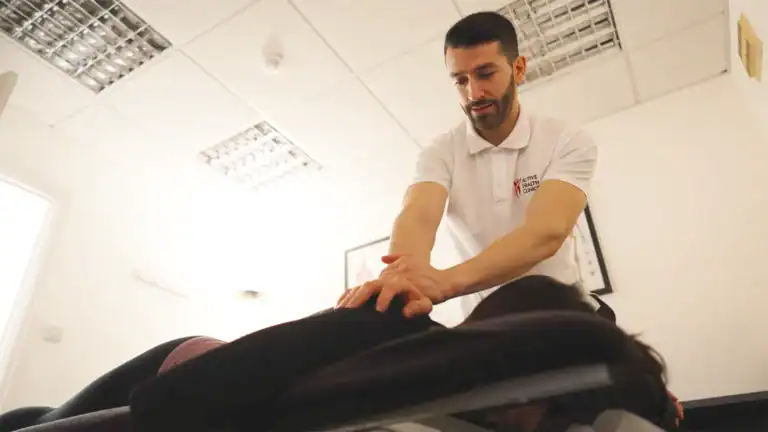October is Spine Health Awareness Month, and I’d like to share some of the best benefits of having a healthy spine because at Active Health Clinics, I love helping people live the happiest and healthiest versions of themselves possible.
As a chiropractor, I have seen just how a healthy spine can improve someone’s quality of life, and how it doesn’t matter your age or activity level, just about everyone can benefit from looking after their spine. It’s so important, that I routinely tell my patients about a ‘rule of thumb’ that I personally follow for my own spinal health, and the rule is this: Whatever decade of life you are in, that is about the number of times to be treated in a given year. So, for example, I’m in my 30s, so I always make sure that my minimum dose of chiropractic treatment is 4 times per year, even if I feel nothing is necessarily ‘wrong’.
Why, might you ask? Below are several benefits that a healthy spine can provide when it’s given the movement that it needs:
Reduced pain and inflammation.
A healthy spine can help you avoid or manage common conditions such as back pain, neck pain, sciatica, arthritis, and headaches. By keeping your spine aligned and flexible, you can reduce the pressure on your nerves, muscles, and joints, and prevent chronic inflammation that can cause pain and damage.
Improved posture and balance.
A ‘well-oiled’ and health spine can help you maintain your posture and balance, which are essential for going about your daily activities and maintaining overall health. Getting your posture right can prevent muscle fatigue, enhance your breathing and circulation, and even boost your confidence and mood, and poor balance can lead to falls, injuries, and fractures, especially as you age.
Enhanced performance and function.
A healthy spine can also help you perform better in your work, hobbies, sports, and other activities that require physical stress (even if it’s just sitting at your desk). Likewise, a healthy and flexible spine can support your core muscles, which are responsible for stabilizing your body and transferring force between your upper and lower limbs, so if you like to walk, run or play a sport, it’s much more enjoyable when your spine is in good working order allowing you to move freely, efficiently, and without limitations or compensations.
Increased energy and vitality.
A healthy spine can also help you feel more energetic and vital, as it can improve your nervous system function, which controls all the other systems in your body. A healthy spine can ensure that your brain receives optimal signals from your body, and that your body receives optimal signals from your brain. This is especially important for our balance and pain centers of our brain which rely on good information coming from out connective tissues and joints.
This can enhance your mental clarity, focus, memory, creativity, and mood. A healthy spine can also improve your immune system function, which can help you fight off infections and diseases, which is ever so important heading into the colder months.
So how can you achieve a healthy spine?
I recommend following these 3 simple steps:
1. Find a way to move well – preferably without pain.
The first step is to assess your current spinal health and function, and identify any issues or challenges that may be affecting it. For most people, this requires the help of a professional who can diagnose the root cause of your problem, and design a personalized plan to address it. This may include chiropractic adjustments, physiotherapy exercises, massage therapy, acupuncture, or other modalities that can help you restore your spinal alignment, mobility, stability, and function.
2. Move more often.
The second step is to increase your physical activity level, and incorporate more movement into your daily routine. This can help you build strength, endurance, flexibility, and resilience in your spine and the rest of your body. Movement can also stimulate blood flow, oxygen delivery, nutrient uptake, waste removal, and healing in your tissues. Movement can also release endorphins, which are natural painkillers and mood enhancers. Some examples of movement you can do are walking, swimming, cycling, yoga, pilates, stretching, or any other activity that you enjoy and that suits your ability level.
3. Reach toward a physical goal appropriate for your current ability.
The third step is to set a long-term vision for what you want to achieve with your spinal health and overall health in the future. This can help you stay motivated and focused on your progress and results. It can also help you overcome any setbacks or challenges that may arise along the way. Your goal should be realistic but challenging enough to push you out of your comfort zone. It should also be specific and measurable so that you can track it and celebrate it when you reach it.
Your goal may be related to improving a specific aspect of your spinal health or function (such as reducing pain or increasing range of motion), or to achieving a broader outcome (such as being able to play with your grandchildren or run a marathon). Whatever it is, make sure it is something that matters to you and that inspires you.
Remember: Your spine is an important indicator of your overall health and well-being. By taking care of it now, you can enjoy its benefits for years to come.
If you would benefit from working with a professional to look at your gut health, then our team is here to help.
You can head to our online booking system to book a consultation.
We even have a no-obligation 15 minute appointment where we’ll discuss what you’re experiencing. We’ll then offer our advice and guidance on what treatment options would best help resolve the problem.
Happy Spine Awareness Month-see you at the clinic!
[/fusion_text][/fusion_builder_column][/fusion_builder_row][/fusion_builder_container]


